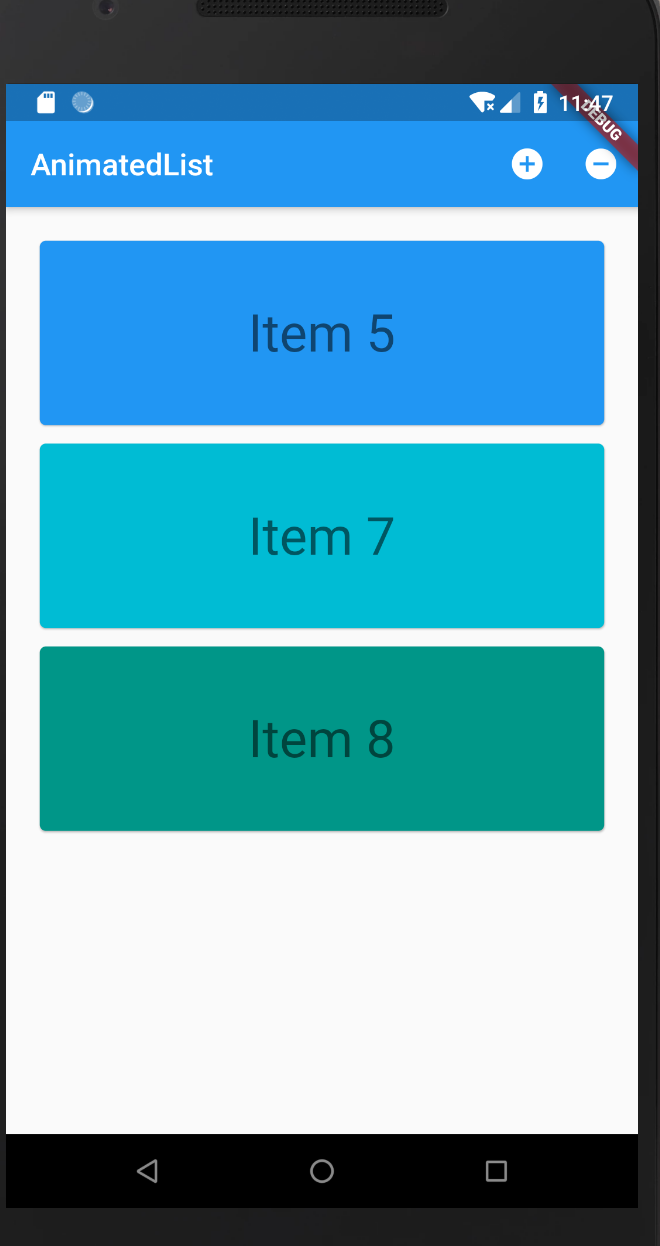
import 'package:flutter/foundation.dart'; import 'package:flutter/material.dart'; void main() { runApp(new AnimatedListSample()); } class AnimatedListSample extends StatefulWidget { @override _AnimatedListSampleState createState() => new _AnimatedListSampleState(); } class _AnimatedListSampleState extends State<AnimatedListSample> { final GlobalKey<AnimatedListState> _listKey = new GlobalKey<AnimatedListState>(); ListModel<int> _list; int _selectedItem; int _nextItem; // The next item inserted when the user presses the '+' button. @override void initState() { super.initState(); _list = new ListModel<int>( listKey: _listKey, initialItems: <int>[0, 1, 2], removedItemBuilder: _buildRemovedItem, ); _nextItem = 3; } // Used to build list items that haven't been removed. Widget _buildItem(BuildContext context, int index, Animation<double> animation) { return new CardItem( animation: animation, item: _list[index], selected: _selectedItem == _list[index], onTap: () { setState(() { _selectedItem = _selectedItem == _list[index] ? null : _list[index]; }); }, ); } // Used to build an item after it has been removed from the list. This method is // needed because a removed item remains visible until its animation has // completed (even though it's gone as far this ListModel is concerned). // The widget will be used by the [AnimatedListState.removeItem] method's // [AnimatedListRemovedItemBuilder] parameter. Widget _buildRemovedItem(int item, BuildContext context, Animation<double> animation) { return new CardItem( animation: animation, item: item, selected: false, // No gesture detector here: we don't want removed items to be interactive. ); } // Insert the "next item" into the list model. void _insert() { final int index = _selectedItem == null ? _list.length : _list.indexOf(_selectedItem); _list.insert(index, _nextItem++); } // Remove the selected item from the list model. void _remove() { if (_selectedItem != null) { _list.removeAt(_list.indexOf(_selectedItem)); setState(() { _selectedItem = null; }); } } @override Widget build(BuildContext context) { return new MaterialApp( home: new Scaffold( appBar: new AppBar( title: const Text('AnimatedList'), actions: <Widget>[ new IconButton( icon: const Icon(Icons.add_circle), onPressed: _insert, tooltip: 'insert a new item', ), new IconButton( icon: const Icon(Icons.remove_circle), onPressed: _remove, tooltip: 'remove the selected item', ), ], ), body: new Padding( padding: const EdgeInsets.all(16.0), child: new AnimatedList( key: _listKey, initialItemCount: _list.length, itemBuilder: _buildItem, ), ), ), ); } } /// Keeps a Dart List in sync with an AnimatedList. /// /// The [insert] and [removeAt] methods apply to both the internal list and the /// animated list that belongs to [listKey]. /// /// This class only exposes as much of the Dart List API as is needed by the /// sample app. More list methods are easily added, however methods that mutate the /// list must make the same changes to the animated list in terms of /// [AnimatedListState.insertItem] and [AnimatedList.removeItem]. class ListModel<E> { ListModel({ @required this.listKey, @required this.removedItemBuilder, Iterable<E> initialItems, }) : assert(listKey != null), assert(removedItemBuilder != null), _items = new List<E>.from(initialItems ?? <E>[]); final GlobalKey<AnimatedListState> listKey; final dynamic removedItemBuilder; final List<E> _items; AnimatedListState get _animatedList => listKey.currentState; void insert(int index, E item) { _items.insert(index, item); _animatedList.insertItem(index); } E removeAt(int index) { final E removedItem = _items.removeAt(index); if (removedItem != null) { _animatedList.removeItem(index, (BuildContext context, Animation<double> animation) { return removedItemBuilder(removedItem, context, animation); }); } return removedItem; } int get length => _items.length; E operator [](int index) => _items[index]; int indexOf(E item) => _items.indexOf(item); } /// Displays its integer item as 'item N' on a Card whose color is based on /// the item's value. The text is displayed in bright green if selected is true. /// This widget's height is based on the animation parameter, it varies /// from 0 to 128 as the animation varies from 0.0 to 1.0. class CardItem extends StatelessWidget { const CardItem({ Key key, @required this.animation, this.onTap, @required this.item, this.selected: false }) : assert(animation != null), assert(item != null && item >= 0), assert(selected != null), super(key: key); final Animation<double> animation; final VoidCallback onTap; final int item; final bool selected; @override Widget build(BuildContext context) { TextStyle textStyle = Theme.of(context).textTheme.display1; if (selected) textStyle = textStyle.copyWith(color: Colors.lightGreenAccent[400]); return new Padding( padding: const EdgeInsets.all(2.0), child: new SizeTransition( axis: Axis.vertical, sizeFactor: animation, child: new GestureDetector( behavior: HitTestBehavior.opaque, onTap: onTap, child: new SizedBox( height: 128.0, child: new Card( color: Colors.primaries[item % Colors.primaries.length], child: new Center( child: new Text('Item $item', style: textStyle), ), ), ), ), ), ); } }